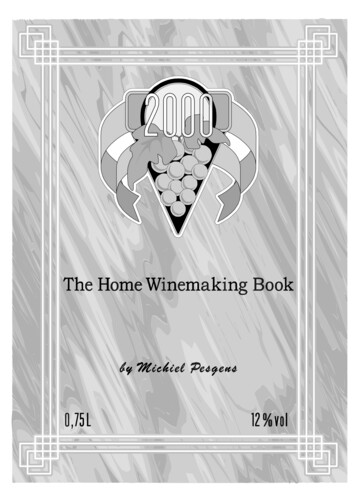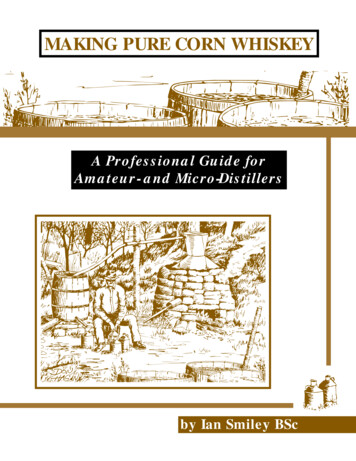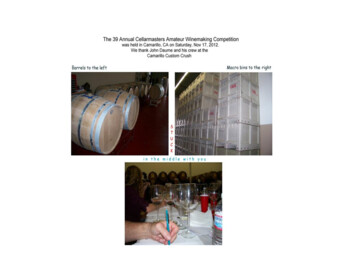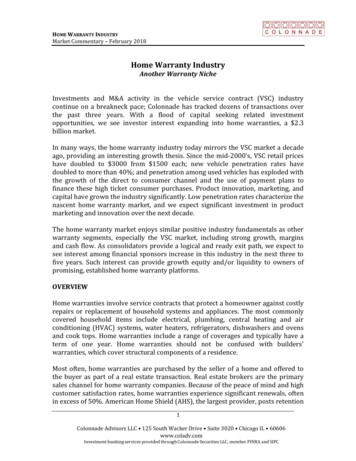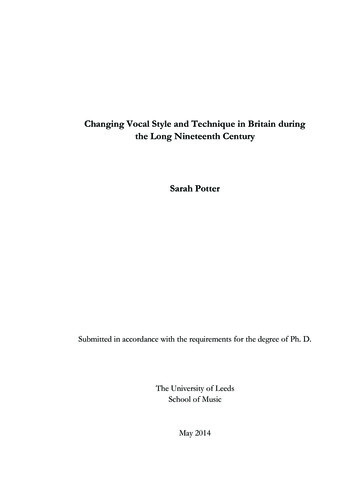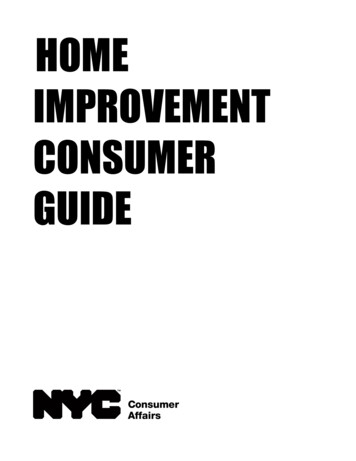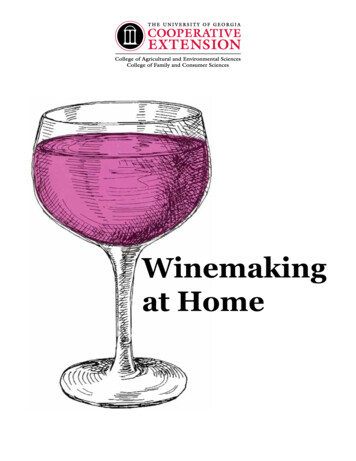
Transcription
Winemakingat Home
ContentsLegal Obligations.3Equipment.4Ingredients.5Winemaking Process.7Illustrations.10Wine Recipes.15Blackberry or Blueberry Wine – Dry. 15Blackberry or Blueberry Wine – Sweet. 15Raspberry or Strawberry Wine – Dry.16Raspberry or Strawberry Wine – Sweet.16Apple or Crabapple Wine – Dry. 17Apple or Crabapple Wine – Sweet. 17Peach or Plum Wine – Dry.18Peach or Plum Wine – Sweet.18Pear Wine – Dry.19Pear Wine – Sweet.19Muscadine Grape Wine – Dry. 20Muscadine Grape Wine – Sweet.21Winemaking Supplies.22References.23Winemaking at Home2University of Georgia Cooperative Extension Circular 717
Winemaking at HomeBy William C. HurstExtension Food ScientistWine can be made from any material capable of growing yeast. This process of active yeast growth onfoodstuff is called alcoholic fermentation. The yeast feeds on the fruit sugar and converts it into ethylalcohol and carbon dioxide gas. This process gradually depletes the sugar content as the percentage ofalcohol increases. The distinct flavor and aroma of an individual wine comes from small quantities ofother chemical substances produced during fermentation. In addition, the flavor and aroma are furtherenhanced by proper aging of the wine.Fruits, berries and grapes readily support fermentation to produce wine. For this reason, they are thebest sources to use in making wine. Many people, especially those having home fruit orchards, wild orcultivated grapes and berries growing on their property, have taken up home winemaking as a hobby.They have found it to be a challenging and rewarding diversion from the daily life routine.This making of good quality wine involves more than just following granny’s recipes. Winemaking is ascience and as such requires close attention to detail. Fermentation must be carefully controlled to avoidspoilage which renders the wine unpalatable. Cleanliness is essential in all phases of winemaking. Ifutensils are not thoroughly cleaned and sterilized, they may contaminate the wine. Ingredients, particularly the fruit, must be of high quality, free from decay and external contaminates.The purpose in writing this bulletin is to provide essential material and detailed instructions for successfully making wine at home. The information described here is designed for beginners who do not knowwhere to begin and for those experienced amateurs who frequently run into difficulties and disappointments.Legal ObligationsIMPORTANT NOTE: Under federal law the head of a family is allowed to produce,for home consumption only, up to 200 gallons of wine annually without paymentof tax. However, before starting to make beer one must file, in duplicate, copies ofForm 1541 with the Internal Revenue Service Regional office. The address of theSoutheast Regional office is:Assistant Regional CommissionerInternal Revenue ServiceAlcohol and Tobacco Tax DivisionFederal Office Building275 Peachtree StreetAtlanta, Georgia 30303University of Georgia Cooperative Extension Circular 7173Winemaking at Home
Equipment(See Page 10)The equipment required for making wine depends a great deal upon the quantity to be processed duringa given period of time. On the average, the home wine maker will only produce from one to five gallonsat a time. A list of equipment and other supplies needed to make wine at home follows:1.A rolling pin, or food grinder, or food chopper is used to crush the fruit. Choppers with quarterinch plates are ideal for crushing fruit without splitting the seeds.2.A primary fermentor is a large (8 gallon) open container in which the ingredients are mixed andinitial fermentation takes place. Food grade polyethylene containers are best to use because theyare easy to clean and do not affect the taste of the wine. Glass or ceramic pots and stainless steelcontainers are heavy and difficult to handle. All other materials, especially aluminum and copper,should be avoided due to their toxicity. Wooden containers are acceptable but are difficult to keepclean.3.A secondary fermentor is a smaller (1, 3 or 5 gallon) container having and opening only largeenough to securely place a fermentation lock. Several sizes may be needed for wine making.These containers are made of heavy glass or high-density polyethylene. Fermenting juice is transferred to these containers one to seven days after the start of fermentation.4.A fermentation lock is a device attached to a rubber stopper which is designed to fit into the secondary fermentor. It is important for the device to be secured so carbon dioxide gas can escapefrom the fermentor without letting in any air. Air contact can spoil the wine by oxidation or cancontaminate the wine with acetic bacteria. These bacteria convert the alcohol in the fermentingjuice to vinegar. Several commercially made locks are available or one can be made with a onehole stopper, glass tubing, and a length of rubber or plastic tubing as follows:Insert the piece of glass tubing in the stopper. Place both in the small opening of the fermentor. Attach one end of the hose to the exposed glass tubing and submerge the other end in amason jar filled with cold water.5.A hydrometer is a simple and inexpensive instrument which takes the guesswork out of winemaking. It is used to measure the amount of sugar in the fruit juice prior to fermentation. It alsotells when fermentation is completed. A hydrometer is essential for consistent results in homewinemaking. Its use is further explained in this publication. The hydrometer and cylinder arepurchased as a set from a scientific supply house.6.A siphoning unit, 3/8-inch diameter rubber hose or plastic tubing which is five to six feet long, iscommonly used to transfer wine from one container to another (racking), and finally into the bottles. The best flow rate is achieved when the upper container is about 18-inches above the lowercontainer.Campden tablets or potassium metabisulfite are used as a source of sulfur dioxide to check thegrowth of wild yeast and vinegar bacteria in the fermenting juice or finished wine. These agentsalso protect the color and flavor of the wine.7.8.A wooden hand corker, or mallet, and size no. 9 cork are used in corking standard wine bottles.The corks must be sterilized before insertion. Submerge the corks in a solution containing twoquarts hot water and ½ level teaspoon potassium metabisulfite or 4 Campden tablets for 15 minutes.Winemaking at Home4University of Georgia Cooperative Extension Circular 717
Rinse and soak them in fresh tap water an additional 15 minutes. Rinse and allow excess water todrain off, then drive the softened corks into filled bottles with a mallet or corker allowing a 3/8inch headspace. After corking, store the bottles in an upright position for one week to allow timefor the corks to harden. Then turn the bottles on their side to keep the corks moist and store thebottles at 60º F.9.Standard wine bottles with screw tops or standard size champagne bottles with plastic corks aregood for holding wine. These can be obtained at restaurants. It is best to use plastic bottles thatare tinted since light affects the color of some wines. If tinted bottles are not available, use clearglass, but store them in a dark place.Clean and sterilize used wine bottles with hot water and a weak solution of bleach (1 tablespoonbleach to a gallon of water). Screw caps and plastic corks are sterilized using potassium metabisulfite.10.A pressing bag or straining cloth is needed to separate the fruit pulp solids from the liquid. Aburlap or well-sewn canvas bag, 12-inches wide by 14-inches deep, is best for straining. However,having nothing better, cheesecloth or a diaper can be stretched over a “food grade” polyethylenebucket or stainless steel mixing bowl. Clothespins can be used to hold the straining cloth in placewhen the fruit pulp and juice are poured into the container. Remember to wash and sterilizestraining bags and cloth before use.Miscellaneous items which will be needed include: a large saucepan, a long-handled plastic spoon, ameasuring cup and a set of measuring spoons, masking tape or pieces of rope, a funnel, extra cheesecloth, also gummed labels, a marking pen, a long-handled brush for cleaning, and bathroom or platformtype scales for weighing juice.IngredientsFruitThe maturity and condition of the fruit being used for fermentation is very important in winemaking.Green fruit is generally high in acid and low in sugar content. Fruit of this type gives a tartness to wine,lacking a true fruity flavor. Fully ripe fruit is at its lowest acid and highest sugar content, and this iswhen fruit is at its best for winemaking, for it leaves a pleasant fruit flavor to the finished wine. Sound,firm fruit will contain most of the supplements necessary to complete the fermentation process. Overripe or bruised fruit has begun to mold and decay even though it may not be noticeable. If fruit of thistype is used, a disagreeable flavor will result.YeastFlavor and taste of the finished wine is largely determined by the type of yeast used in fermentation. Forbest results, use only a true wine yeast such as Montrachet No. 522, which is available from wine supplyhouses. An acceptable second choice is Baker’s yeast. Yeasts are living organisms and as such requirea balanced diet for proper development. The muscadine grape, when properly grown, is one of the fewfruits containing all the necessary food supplements for yeast growth. Most other fruits are lacking insome part of the yeast requirements, even some wine grapes. A balanced yeast food known as nutrientmust be added with the yeast at the start of fermentation. Yeast nutrient is commercially available atwine supply houses. Good substitutes for this nutrient include a pinch of ammonium phosphate (commercial fertilizer) or a small handful of minced raisins per gallon of crushed fruit.University of Georgia Cooperative Extension Circular 7175Winemaking at Home
AcidFruits vary a great deal in their acid content or tartness. Lack of acid gives wine an insipid taste whiletoo much acid gives a sharp tang and can affect fermentation. Correct wine acidity brings out the fullflavor of the fruit. Acid strength in the juice should be from one-half to three-fourths of one percent.Grapes are high in tartaric acid and usually the finished grape wine has this desired acidity. Some, suchas apple wine, are low in acidity and require the addition of citric acid or some lemon juice to the fruitjuice before fermentation begins to improve the flavor. Add approximately one tablespoon lemon juiceper gallon strained juice or pulp.TanninTannin gives wine its bite or astringency to overcome the greatest fault in wine, that of insipidness orflatness. Pears and grapes contain sufficient tannin in the skins and stems for winemaking, however,many other fruits including all white wines are lacking in tannin. To give wine its proper astringency,tannin must be added to these wines. Powdered tannin can be purchased commercially at wine supplyhouses with directions for its use. If tannin is not readily available, add several tablespoons of strong teato the fermenting crushed fruit to improve the astringency of the finished wine.SugarThe amount of sugar used controls the sweetness of the wine and at the same time is directly responsible for its alcohol content. Sugar, when fermented, gives one-half its amount of alcohol by volume. Thus,when completely fermented, a fruit having 22 percent sugar (fruit sugar plus added sugar) will give awine with 11 percent alcohol. Wine containing less than 10 percent alcohol content will be thin and sourand will not keep. Under normal circumstances most yeasts have difficulty completing fermentation atsugar levels above 24 percent. Hence any sugar content in excel of 24 percent is going to remain in thefinished product, resulting in sweet wine.Sugar used in winemaking can be either ordinary household sugar or corn sugar also known as dextrose.Dextrose can be purchased at wine supply houses and is said to produce smoother wine when largeamounts of sugar are needed. Sugar is best added to the raw juice in the form of sugar syrup, preparedby dissolving two cups sugar in one cup boiling water. One cup of sugar syrup is then equivalent to a 50percent sugar solution. Adding several cups of sugar syrup every few days until the total sugar requirement has been met is the best method of keeping a good strong fermentation in progress.GelatinOrdinarily, a wine of good alcoholic strength will clear itself if allowed to stand. But it sometimes happens, after several rackings, that a wine apparently good in other respects refuses to clear up properly.These wines may be artificially clarified using powdered kitchen gelatin. Measure out one level teaspoongelatin for every five gallons wine. Add the gelatin to about a quart of drawn wine and dissolve by warming to 100º F while mixing well. Return this quart to the original bulk of wine and stir for 10 minutes,seal and let stand until wine clears. Since the gelatin settles tannin, along with other impurities, it is necessary to add tannin (amount equal to that of gelatin used) back to the wine.Winemaking at Home6University of Georgia Cooperative Extension Circular 717
The Winemaking Process(See Pages 11-13)Step 1 – CleaningClean all winemaking equipment and bottles thoroughly before starting an operation. Don’t use soap ordetergents as their residues can impart an off-taste to the wine. Use hot water and a long-handled stiffbrush to clean primary and secondary fermentors and bottles. To remove the industrial film off polyethylene, fill the container with hot water and add a pound of baking soda; then let set several hours beforerinsing. After cleaning, swirl a weak bleach solution (1/4 cup bleach per gallon of water) in the containers to disinfect them. Use hot water to rinse through the siphon hose.Step 2 – Preparing the FruitTo begin, remove stems and unripe fruit. Trim or remove all rotten fruit. Rinse the fruit with cool waterand allow to drain in a colander. Crush the fruit in order to free the juice for fermentation. Soft fruitssuch as berries and grapes can best be handled by spreading a thin layer in the bottom of a large flatsauce pan and crushing them with a rolling pin or potato masher. Much better results are obtained withsolid fruits, such as apples, when they are crushed in a food chopper.NOTE: If white wine is desired, the juice is immediately separated from the fruit skins and pulp usinga pressing bag or straining cloth and transferred to the secondary fermentor. For red wine, transfer theentire contents (juice, pulp, skins) to the primary fermentor.Step 3 – Determining Sugar ContentThe sugar content present in the juice prior to fermentation must be measured in order to know theexact amount of sugar needed to increase the level to 22 percent. To measure sugar content with a hydrometer, fill the glass cylinder with a sample of strained juice and immerse the heavy end of the hydrometer in it. Put the jar on a level surface and let the hydrometer ride in the juice until it becomesperfectly still. When it comes to rest, away from the sides of the cylinder, read the value at the surface ofthe liquid (not the part of the liquid which has climbed up the side of the instrument). Record this figureimmediately so it will not be forgotten! The temperature of the juice should be about 75º F when thereading is taken.Step 4 – Sterilizing FruitDissolve either four Campden tablets or one-half teaspoon potassium metabisulfate in a pint of strainedjuice. Add this back to either the primary fermentor containing crushed fruit or to the secondary fermentor containing strained juice. Mix thoroughly, cover the container with double layered cheesecloth,secure in place with a rope, and wait four hours before proceeding to Step 5.Step 5 – Adding of NutrientsFor fruits, other than grapes, add sufficient tannin (tea), citric acid (lemon juice), yeast nutrient (raisins)and sugar syrup to either the crushed fruit or strained juice as called for in the recipe.Step 6 – Activating Wine YeastActivate a package of wine yeast (or Baker’s yeast as the second choice) by dissolving it in a cup ofstrained juice. Add this to the crushed fruit or strained juice and mix well.University of Georgia Cooperative Extension Circular 7177Winemaking at Home
Step 7 – Extracting Color for Red WineCover the primary fermentor containing the crushed fruit with double layered cheesecloth, secure inplace with a rope, and store in a warm place (60-70º F) such as a cellar or basement. Fermentationshould begin within 24 hours. By the second day, the pulp should be in strong ferment. The solids in thepulp will float to the surface to form a cap over the fermenting juice.At least twice a day this cap should be stirred thoroughly into the juice, always replacing the cover. It ismost important that the fermenting pulp and juice be protected from small vinegar flies and other insects by covering during this period. Allow the fruit pulp to ferment from three to seven days in order toextract the desired color from the skins.Step 8 – Straining Fruit PulpUsing a pressing bag or several layers of cheesecloth, squeeze or strain the solids from the fermentingjuice into a large saucepan. It is best to strain off the clear liquid first by holding back the surface solids,then gather the remaining solids in the bag or cloth and squeeze dry by slowly applying pressure. Do notsqueeze hard enough to force pulp through the cloth and into the juice. Transfer the contents to the secondary fermentor using a plastic funnel to avoid spillage.Step 9 – Determining Sugar NeededThe amount of sugar required to raise the sugar level of the juice to 22 percent can be calculated by aformula called the Pearson Square. It is diagramed below.An example of how to use this formula for making five gallons of wine is as follows:A sample of strained peach juice, drawn from a bushel of freshly crushed peaches was found tocontain 10 percent sugar (value read at liquid’s surface when tested with a hydrometer). Afterprimary fermentation to extract color, 35 pounds of fermenting juice – determined by the difference between fermentor weight and fermentor weight juice weight – were separated from theskins, seeds, and pulp. How much sugar (cups sugar syrup) should be added to the 35 pounds ofjuice to increase the initial sugar level of the juice from 10 to 22 percent?To begin:1. Place in the upper left-hand corner or a square the percent of sugar in the syrup. Syrup prepared ata rate of two cups sugar to one cup water contains 50 percent sugar.2. In the lower left-hand corner place the percent of sugar (10) in the strained juice.3. In the center of the square place the percent of sugar level (22) desired.4. Now subtract the center figure from the figure in the upper left-hand corner, and place the remainder in the lower right-hand corner (50 – 22 28).5. Subtract the figure in the lower left-hand corner from the figure in the center and place the remainder in the upper right-hand corner (22-10 12).This last figure (12) is the number of cups of a 50 percent sugar syrup which must be added to 28pounds of juice to increase the sugar level from 10 to 22 percent. But in this example, there are 35pounds of juice. Therefore, to determine the number of cups of syrup required, simply divide thetotal pounds of juice (35) by the number in the lower right-hand corner of the square (28) and multiply by the number in the upper right-hand corner (12). First, divide 35 by 28 ( 1.25), the multiply the quotient by 12 (1.25 x 12 15). The result (15) will be the number of cups of sugar syrupwhich must be added to 35 pounds of juice to increase the sugar level from 10 to 22 percent.Winemaking at Home8University of Georgia Cooperative Extension Circular 717
Step 10 – Fermenting Red WineDissolve the sugar required in water at a rate of two cups sugar to one cup water. Sterilize by briningto a rolling boil for a few minutes before setting aside to cool to room temperature. Add several cups ofthe sugar syrup to the fermenting juice and swirl gently to distribute. Don’t add the entire sugar syrupsolution to the fermenting juice because it may cause excessive bubble formation, resulting in overflow.Adding all the syrup may also stun or kill the yeast producing an inferior wine of low alcohol strength.Next, seal the fermentor with a snug-fitting fermentation lock and set this container in a place havinga constant temperature of between 60-70º F. Within a day or two, carbon dioxide bubbles will be seensteadily emerging from the fermentation lock, an indication that active fermentation has begun. Fermentation must be vigorous so that the heavier than air carbon dioxide gas produced will lie on top ofthe juice like a blanket to stop the yeast from obtaining oxygen from the air. Carefully remove the lockand add two cups sugar syrup, then quickly and securely replace the lock back in place on the fermentor.Gently swirl the container to dissolve the syrup. Repeat this process every four to five days or until thesolution is entirely used. Fermentation will proceed about a month.Step 11 – Fermenting White WineIf fruit juice only had been used, there should be no solids to strain out and the liquid would have beenplaced into the secondary fermentor. While the strained juice is being sterilized, dissolve the sugar required in water, sterilize and cool as before. Follow the same recommendations for adding sugar as werestated for making red wine. Store the container at a temperature of between 60-70º F until fermentationalmost ceases.Step 12 – Racking the WineDuring the process of fermentation, a whitish, fine sediment, comprised mainly of dead yeast cells, isdeposited on the bottom of the secondary fermentor. Racking is the process designed to separate thewine from this sediment and is performed by siphoning the wine from one container to another whenfermentation has practically come to a stop. Using a chair or table, place the secondary fermentor 18inches above the tope of a cleaned and sterilized five-gallon fermentor located on the floor. Insert arubber hose approximately three-eights-inch in diameter and about five feet long into the secondaryfermentor. Siphon the wine from this upper container into the lower one taking care not to stir up thesediment.During this first racking, allow the wine to aerate slightly by falling from the middle of the container tothe bottom. This oxygen is utilized by the remaining yeasts in the wine to complete the fermentationprocess. Add one-eighth-teaspoon potassium metabisulfite or one Campden tablet for every three gallons of siphoned wine to prevent spoilage. Replace the fermentation lock and wait a month before thenext racking in order for fermentation to run to completion.Some wines continue a very slow fermentation for several months and remain cloudy. They may requireracking three or four times before they become sparkling clear and are ready for bottling. In each case,racking should be done without aeration, that is, the siphoning hose should be submerged below the liquid in the lower container to keep air out of the wine.University of Georgia Cooperative Extension Circular 7179Winemaking at Home
Equipment1. Rolling pin, or food2. Primary fermentorgrinder, or food chopper3. Secondary fermentor4. Fermentation lock6. Siphoning unit5. Hydrometer7. Campden tablets or po- 8. Wooden hand corkertassium metabisulfiteWinemaking at Home1010. Pressing bag or straining clothUniversity of Georgia Cooperative Extension Circular 717
The Winemaking ProcessStep 1 – CleaningStep 2 – Preparing the FruitStep 3 – Determining Sugar ContentStep 4 – Sterilizing FruitUniversity of Georgia Cooperative Extension Circular 71711Winemaking at Home
Step 6 – Activating Wine YeastStep 7 – Extracting Color for Red WineStep 8 – Straining Fruit PulpStep 10 – Fermenting Red WineWinemaking at Home12University of Georgia Cooperative Extension Circular 717
Step 12 – Racking the WineStep 14 – Bottling the WineUniversity of Georgia Cooperative Extension Circular 71713Winemaking at Home
Step 13 – Clarifying the Wine – OptionalThe chilling (30-40º F) of grape wine, after racking, prompts the natural clarification of this wine. Unwanted matter and suspended solids including potassium bitartrate, are precipitated as crystals in thebottom of the container. Other wines can be treated with gelatin if they will not clear under any circumstances. The gelatin combines with tannin present in the mix to form a milky colored solution. This willin turn settle slowly, dragging down any suspended materials to the bottom of the fermentor. It will takeabout a month for the wine to clarify, after which it is siphoned from the sediment. The disadvantage ofusing this treatment is that tannin, which gives wine its unique taste, is removed. It is necessary then tomix tannin back into the wine using approximately the weight of gelatin needed to initiate clarification.Step 14 – Bottling the WineWhen fermentation has completely stopped, the wine should be sparkling clear and ready to bottle.Wine should be siphoned without aeration into bottles for aging. This limits the chance of off-flavor andoff-color development due to oxidation.Also, dissolve one-eighth-teaspoon potassium metabisulfite or one Campden tablet for every three gallons of wine in the fermentor prior to siphoning into bottles to prevent bacterial spoilage. An inexpensive hand corker, which is driven by a mallet, can be used to drive corks into wine bottles. In addition, asmall corking machine operated by levers can be used to compress corks into the bottles. If screw-topsor plastic tops are used, cap the bottles loosely the first day of filling to allow residual gases to escape.Next day, tighten them in place.Once wine has been bottled, each bottle should be labeled giving information as to its sweetness, flavor,clarity, etc. Also, a file or notebook should be kept on winemaking procedures so fine adjustments can bemade from one year’s production to another in order to produce wines exactly as you would like to havethem.Step 15 – Storing the WineWines age best at an even 60º F temperature. A clean, dry basement shielded from light is an ideal placefor wine storage. Wine should be stored on its side to keep the cork moist and to prevent the entranceof spoilage bacteria. During aging, subtle changes in the flavor of wine take place contributing to eachwine’s characteristic bouquet and appeal. Sedimentation may take place with aging. If sediment does occur, carefully decant the clear wine to a clean bottle before serving.Wine can be consumed anytime after bottling; however, increased aging will mellow and bring out theunique flavors of the wine. For superior clarity and flavor, wine must be aged about a year before consumption.Winemaking at Home14University of Georgia Cooperative Extension Circular 717
Wine RecipesA wine recipe can be nothing more than a basic guide to making wine. This is due to the variables thatoccur in the composition of a specific fruit when grown under varying climatic, soil, and seasonal conditions. Generally, hot, dry weather will produce more sugar in a fruit, while cool, damp weather tends toincrease the acidity. In addition, the degree of fruit maturity affects its sugar-acid ration, riper fruit being higher in sugar content and green fruit being more acidic. These are some of the factors that must beconsidered in formulating an acceptable wine recipe.Some selected fruit recipes which will make both dry and sweet wines follow. For consistent results inmaking good quality dry wines, a hydrometer should be used to measure critical sugar needs; muchmore sugar than the critical amount will produce a sweet wine. To prevent bacterial spoilage, winesmust have 11
a given period of time. On the average, the home wine maker will only produce from one to five gallons at a time. A list of equipment and other supplies needed to make wine at home follows: 1. A rolling pin, or food grinder, or food c
